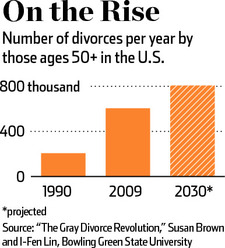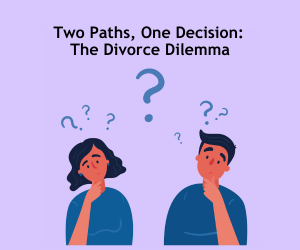
According to a Bowling Green State University study, the divorce rate for those over 50 more than doubled between 1990 and 2009. The trend suggests that by 2030 there will be more than 800,000 divorces per year for the 50 plus age group. This unprecedented rise in gray divorces is occurring while the divorce rate among younger couples is declining.

I will not be a year 2030 statistic. My divorce was final in 2010 after a 32-year marriage, which most definitely puts me in that age 50 plus boomer group. While the Bowling Green study and an endless amount of other research discusses some of the reasons and causes for this divorce demographic, I want to focus on how the issues are different for gray divorces and yet the same as those divorcing at much younger ages.
In my experience, working with spouses as a financial neutral every divorce is unique to each family. However, all divorces have some broad common foundational issues. Every divorce, whether you are in your 50’s and above or younger, has at least some financial issues to be resolved. Divorce financial issues involve allocating assets and liabilities to each spouse in an effort to be fair and equitable. In addition if there are children under the age of 18 providing for the needs of the children is a consideration. In certain situations, spousal maintenance may come into the play.
What is different about financial issues in gray divorces is hypothetically; there are greater assets and fewer liabilities given their longer life and time in the workforce up to this point than their younger counterparts. In my work as a financial neutral with gray divorcees, I can share with you this is not always the case. Many times assets are limited and debts are significant. A collaborative-trained financial neutral is well equipped to help spouses with these and other financial issues.
There is less time for boomer spouses to recover from the financial loss of divorce. Essentially assets and debts are allocated equally with some exceptions that have the effect of reducing the marital estate in half. Sometimes mothers or fathers have stayed at home or otherwise sacrificed to some degree a working career to care for their children. Now in their 50’s and above they will need to do what they can to work towards becoming self-supporting. This is no small order, as we all know how difficult the job market can be for anyone let alone trying to re enter the workforce when you are gray and training and skills may need to be updated.
When there are children under the age of 18 a parenting plan must be established. Parents ideally come to agreements on how to co-parent their minor children. This is not to imply that children older than 18 are not affected by divorce. My children were all adults over the age of 21 when my divorce occurred and I can share the divorce had an impact on their lives as well as mine and my former spouse. While child support financial obligations and parenting time schedules may not be a factor in gray divorces, those adult children need the support of both parents. Gray divorcing clients would do well to consider the support their adult children need. After all, there will still be birthdays, holidays, weddings, graduations, and yes-even grandchildren in the future. Your children regardless of their age want to know they have two loving and caring parents who will always be there for them.
With gray divorces, there are often decade’s long relationships with extended family members. What will these relationships look like in the future? Will the relationships continue to exist or somehow change a result of the divorce? How will what happens to these relationships affect your adult children? All of these and many more questions arise in gray divorces.
Divorce, regardless of age, is never easy nor does it produce any winners in my opinion. However, those who have made the decision to end their marriage would be wise to become knowledgeable of the
collaborative divorce process.
Collaborative Divorce is well suited to handle gray divorces. This process when successfully completed keeps your divorce out of court and thus keeps it private. More importantly, it keeps the outcome in your control. You and your spouse are able to make decisions about your future not a judge with limited information and time. Collaborative divorce is a process that involves dignity, respect, and acknowledges the contributions of each spouse to their marriage.
If you know of anyone who has made the decision to divorce or is seriously considering divorce you would be doing them a favor by letting them know that collaborative divorce is an option and where they can go for more information. To learn more about collaborative divorce visit
www.collaborativelaw.org.
More Collaborative Law Posts
 According to a Bowling Green State University study, the divorce rate for those over 50 more than doubled between 1990 and 2009. The trend suggests that by 2030 there will be more than 800,000 divorces per year for the 50 plus age group. This unprecedented rise in gray divorces is occurring while the divorce rate among younger couples is declining.
According to a Bowling Green State University study, the divorce rate for those over 50 more than doubled between 1990 and 2009. The trend suggests that by 2030 there will be more than 800,000 divorces per year for the 50 plus age group. This unprecedented rise in gray divorces is occurring while the divorce rate among younger couples is declining.
 I will not be a year 2030 statistic. My divorce was final in 2010 after a 32-year marriage, which most definitely puts me in that age 50 plus boomer group. While the Bowling Green study and an endless amount of other research discusses some of the reasons and causes for this divorce demographic, I want to focus on how the issues are different for gray divorces and yet the same as those divorcing at much younger ages.
In my experience, working with spouses as a financial neutral every divorce is unique to each family. However, all divorces have some broad common foundational issues. Every divorce, whether you are in your 50’s and above or younger, has at least some financial issues to be resolved. Divorce financial issues involve allocating assets and liabilities to each spouse in an effort to be fair and equitable. In addition if there are children under the age of 18 providing for the needs of the children is a consideration. In certain situations, spousal maintenance may come into the play.
What is different about financial issues in gray divorces is hypothetically; there are greater assets and fewer liabilities given their longer life and time in the workforce up to this point than their younger counterparts. In my work as a financial neutral with gray divorcees, I can share with you this is not always the case. Many times assets are limited and debts are significant. A collaborative-trained financial neutral is well equipped to help spouses with these and other financial issues.
There is less time for boomer spouses to recover from the financial loss of divorce. Essentially assets and debts are allocated equally with some exceptions that have the effect of reducing the marital estate in half. Sometimes mothers or fathers have stayed at home or otherwise sacrificed to some degree a working career to care for their children. Now in their 50’s and above they will need to do what they can to work towards becoming self-supporting. This is no small order, as we all know how difficult the job market can be for anyone let alone trying to re enter the workforce when you are gray and training and skills may need to be updated.
When there are children under the age of 18 a parenting plan must be established. Parents ideally come to agreements on how to co-parent their minor children. This is not to imply that children older than 18 are not affected by divorce. My children were all adults over the age of 21 when my divorce occurred and I can share the divorce had an impact on their lives as well as mine and my former spouse. While child support financial obligations and parenting time schedules may not be a factor in gray divorces, those adult children need the support of both parents. Gray divorcing clients would do well to consider the support their adult children need. After all, there will still be birthdays, holidays, weddings, graduations, and yes-even grandchildren in the future. Your children regardless of their age want to know they have two loving and caring parents who will always be there for them.
With gray divorces, there are often decade’s long relationships with extended family members. What will these relationships look like in the future? Will the relationships continue to exist or somehow change a result of the divorce? How will what happens to these relationships affect your adult children? All of these and many more questions arise in gray divorces.
Divorce, regardless of age, is never easy nor does it produce any winners in my opinion. However, those who have made the decision to end their marriage would be wise to become knowledgeable of the collaborative divorce process.
Collaborative Divorce is well suited to handle gray divorces. This process when successfully completed keeps your divorce out of court and thus keeps it private. More importantly, it keeps the outcome in your control. You and your spouse are able to make decisions about your future not a judge with limited information and time. Collaborative divorce is a process that involves dignity, respect, and acknowledges the contributions of each spouse to their marriage.
If you know of anyone who has made the decision to divorce or is seriously considering divorce you would be doing them a favor by letting them know that collaborative divorce is an option and where they can go for more information. To learn more about collaborative divorce visit www.collaborativelaw.org.
I will not be a year 2030 statistic. My divorce was final in 2010 after a 32-year marriage, which most definitely puts me in that age 50 plus boomer group. While the Bowling Green study and an endless amount of other research discusses some of the reasons and causes for this divorce demographic, I want to focus on how the issues are different for gray divorces and yet the same as those divorcing at much younger ages.
In my experience, working with spouses as a financial neutral every divorce is unique to each family. However, all divorces have some broad common foundational issues. Every divorce, whether you are in your 50’s and above or younger, has at least some financial issues to be resolved. Divorce financial issues involve allocating assets and liabilities to each spouse in an effort to be fair and equitable. In addition if there are children under the age of 18 providing for the needs of the children is a consideration. In certain situations, spousal maintenance may come into the play.
What is different about financial issues in gray divorces is hypothetically; there are greater assets and fewer liabilities given their longer life and time in the workforce up to this point than their younger counterparts. In my work as a financial neutral with gray divorcees, I can share with you this is not always the case. Many times assets are limited and debts are significant. A collaborative-trained financial neutral is well equipped to help spouses with these and other financial issues.
There is less time for boomer spouses to recover from the financial loss of divorce. Essentially assets and debts are allocated equally with some exceptions that have the effect of reducing the marital estate in half. Sometimes mothers or fathers have stayed at home or otherwise sacrificed to some degree a working career to care for their children. Now in their 50’s and above they will need to do what they can to work towards becoming self-supporting. This is no small order, as we all know how difficult the job market can be for anyone let alone trying to re enter the workforce when you are gray and training and skills may need to be updated.
When there are children under the age of 18 a parenting plan must be established. Parents ideally come to agreements on how to co-parent their minor children. This is not to imply that children older than 18 are not affected by divorce. My children were all adults over the age of 21 when my divorce occurred and I can share the divorce had an impact on their lives as well as mine and my former spouse. While child support financial obligations and parenting time schedules may not be a factor in gray divorces, those adult children need the support of both parents. Gray divorcing clients would do well to consider the support their adult children need. After all, there will still be birthdays, holidays, weddings, graduations, and yes-even grandchildren in the future. Your children regardless of their age want to know they have two loving and caring parents who will always be there for them.
With gray divorces, there are often decade’s long relationships with extended family members. What will these relationships look like in the future? Will the relationships continue to exist or somehow change a result of the divorce? How will what happens to these relationships affect your adult children? All of these and many more questions arise in gray divorces.
Divorce, regardless of age, is never easy nor does it produce any winners in my opinion. However, those who have made the decision to end their marriage would be wise to become knowledgeable of the collaborative divorce process.
Collaborative Divorce is well suited to handle gray divorces. This process when successfully completed keeps your divorce out of court and thus keeps it private. More importantly, it keeps the outcome in your control. You and your spouse are able to make decisions about your future not a judge with limited information and time. Collaborative divorce is a process that involves dignity, respect, and acknowledges the contributions of each spouse to their marriage.
If you know of anyone who has made the decision to divorce or is seriously considering divorce you would be doing them a favor by letting them know that collaborative divorce is an option and where they can go for more information. To learn more about collaborative divorce visit www.collaborativelaw.org.



